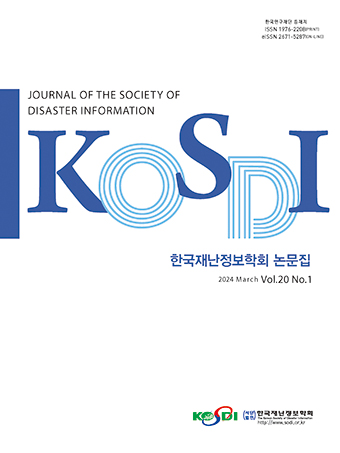Original Article
Abstract
References
Information
Purpose: In this study, a strong wind damage prediction function was developed in order to be used as a contingency during disaster management (preventive-preventive-response-recovery). Method: The predicted strong wind damage function proposed in this study took into account the re-enactment boy power, weather data and local characteristics at the time of damage. The meteorological data utilized the wind speed, temperature, and damage history observed by the Korea Meteorological Administration, the disaster year, and the recovery costs, population, vinyl house area, and farm water contained in the disaster report as factors to reflect the regional characteristics. Result: The function developed in this study reflected the predicted weather factors and local characteristics based on the history of strong wind damage in the past, and the extent of damage can be predicted in a short time. Conclusion: Strong wind damage prediction functions developed in this study are believed to be available for effective disaster management, such as decision making by policy-makers, deployment of emergency personnel and disaster prevention resources.
연구목적: 본 연구에서는 재난관리(예방-대비-대응-복구) 중 대비차원으로 활용하고자 강풍피해예측함수를 개발하였다. 연구방법: 본 연구에서 제안하는 강풍피해예측함수는 재해연보이력, 피해당시 기상자료 그리고 지역특성을 고려하였다. 기상자료는 기상청에서 관측한 풍속과 기온, 피해이력에 해당하는 통계자료는 재해연보, 그리고 지역특성을 반영하기 위한 요소로는 재해연보 상 수록된 복구비, 인구, 비닐하우스 면적, 농가수 등을 활용하였다. 연구결과: 본 연구에서 개발한 함수식은 과거에 발생한 강풍피해이력을 기반으로 예측되는 기상인자와 지역특성을 반영하였으며, 단시간에 피해규모를 예측할 수 있다. 결론: 본 연구에서 개발한 강풍피해예측함수는 정책결정자들의 의사결정, 비상인력 및 방재자원의 배치 등과 같은 효율적인 재난관리에 활용할 수 있을 것으로 판단된다.
- Cho, K.P., Hong, S.I. (2006). "Wind damages of claddings of high-rise apartment building under strong wind." Journal of Architectural Institute of Korea, Vol. 22, No. 2, pp. 43-50.
- Choo, T.H., Kwak, K.S., Ahn, S.H., Yang, D.U., Son, J.K. (2017a). "Development for the function of Wind wave damage estimation at the western coastal zone based on disaster statistics." Journal of the Korea Academia-Industrial cooperation Society, Vol. 18, No. 2, pp. 14-22.
- Choo, T.H., Yun, G.S., Kwon, Y.B., Park, S.J., Kim, S.R. (2017b). "Proposal for wind wave damage cost estimation at the southern coastal zone based on disaster statistics." Journal of the Korea Contents Association, Vol. 17, No. 4, pp. 267-274.
- Franklin, J.L., Black, M.L., Valde, K. (2003). "GPS dropwindsonde wind profiles in hurricanes and their operational implications." Weather and Forecasting, Vol. 18, No. 1, pp. 32-44.10.1175/1520-0434(2003)018<0032:GDWPIH>2.0.CO;2
- Heneka, P., Hofherr, T., Ruck, B., Kottmeier, C. (2006). "Winter storm risk of residential structures? model development and application to the German state of Baden-Württemberg." Natural Hazards and Earth System Science, Vol. 6, No. 5, pp. 721-733.10.5194/nhess-6-721-2006
- Heneka, P., Ruck, B. (2008). "A damage model for the assessment of storm damage to buildings." Engineering Structures, Vol. 30, No. 12, pp. 3603-3609.10.1016/j.engstruct.2008.06.005
- Kim, B.J., Kim, H.K., Lee, S.L., Yoo, J.E. (2006). "On the characteristics of the damage and occurrence of high winds in Korea." Magazine of the Korean Society of Steel Construction, Vol. 18, No. 3, pp. 79-86.
- Kim, J.S. (2013). On the Characteristics of Damage Scale and Risk Management System by Strong Wind Speed of Typhoon. Master's thesis of Inje University.
- Klawa, M., Ulbrich, U. (2003). "A model for the estimation of storm losses and the identification of severe winter storms in Germany." Natural Hazards and Earth System Science, Vol. 3, No. 6, pp. 725-732.10.5194/nhess-3-725-2003
- Lee, S.I. (2013). Study on Damage Scale Prediction by Rainfall and Wind Velocity with Typhoon. Master's thesis of Sunchon University.
- Ministry of Public Safety and Security (2016). The 2016 Annual Natural Disaster Report.
- National Oceanic and Atmospheric Administration (NOAA) (2015). Global Analysis.
- Park, J.K., Jung, W.S., Choi, H.J. (2008). "The Study on the strong wind damage prediction for estimation surface wind speed of typhoon season (I)." Journal of Environmental Science International, Vol. 17, No. 2, pp. 195-201.10.5322/JES.2008.17.2.195
- Seo, K.W. (2004). "Disaster characteristics analysis at Busan coastal areas by typhoon Maemi in 2003." Journal of Ocean Engineering and Technology, Vol. 18, No. 2, pp. 25-32.
- Song, C.Y., Yang, B.S. (2016). "Gale disaster damage investigation process provement plan according to correlation analysis between wind speed and damage cost -Centering on disaster year book-." Journal of the Korean Society of Safety, Vol. 31, No. 2, pp. 119-126.10.14346/JKOSOS.2016.31.2.119
- Statistics Korea (2013). Manual of community indicators.
- Zhai, A.R., Jiang, J.H. (2014). "Dependence of US hurricane economic loss on maximum wind speed and storm size." Environmental Research Letters, Vol. 9, No. 6, 064019.10.1088/1748-9326/9/6/064019
- Publisher :The Korean Society of Disaster Information
- Publisher(Ko) :한국재난정보학회
- Journal Title :Journal of the Society of Disaster Information
- Journal Title(Ko) :한국재난정보학회논문집
- Volume : 16
- No :2
- Pages :223-236
- DOI :https://doi.org/10.15683/kosdi.2020.06.30.223




 Journal of the Society of Disaster Information
Journal of the Society of Disaster Information







